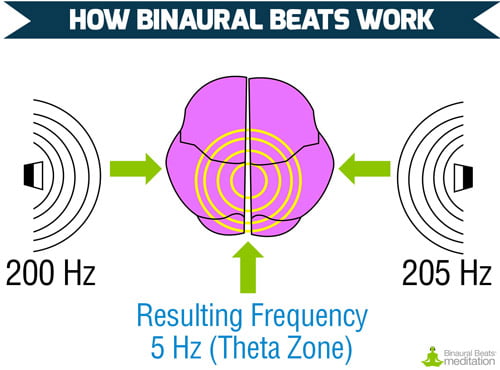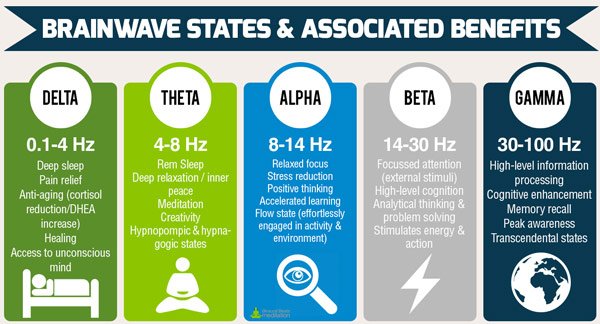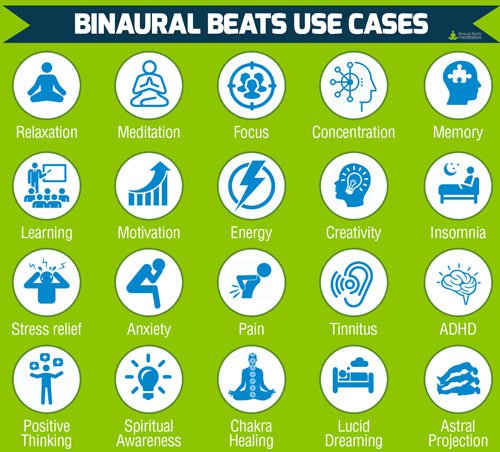How your brain responds to Binural beats
By pradeep - August 01, 2019
Coming soooon....



The benefits listed under each brainwave state are general associations and it should not be assumed that all frequencies within the state’s range will produce these benefits.

How Our Special Music Works
The science behind binaural beats occurs naturally in the brain. A different sound (tone) frequency is sent to the left and right ears through headphones.
Upon hearing the two different frequencies, the brain responds by interpreting the two different frequencies as one consistent, rhythmic sound frequency, known as a binaural beat(s).
The resulting frequency that the brain interprets and subsequently follows along to (entrained), represents the mathematical difference between the two frequencies of the left and right tones that were initially sent to the left and right ears.
This is known as ‘Frequency Following Response' (FFR), a naturally occurring science that has been around for centuries.
In this article we'll step back in time and look at some early forms of brainwave entrainment and music therapy, the discovery of binaural beats, and then explain exactly how our special music works and how it can benefit you.

The Ancient Benefits of Rhythm & Repetition
What most people don't realize is that although the creation of binaural beats music has only been possible through technological advancement in the last 100 or so years, the use of this natural science dates back thousands of years.
Ancient cultures were aware of how the brain could be entrained through sound repetition well before modern science was able to prove the process.
If we look back through history, we find many examples of music being used as medicine and therapy.
The ancient Greeks used music to ease stress, promote sleep, and soothe pain. The Native Americans and Africans used singing and chanting as part of their healing rituals.
Even in language we see a connection between healing and music. For example, the Chinese character for medicine includes the character for music (1).
Of course, in times past societies didn't refer to music therapy, binaural beats, or brainwave entrainment of any kind, but what they did know was that sound had powerful healing properties.
Interestingly, scientist Melinda Maxfield, PhD, conducted research on the drumbeats used during rituals of ancient cultures and found that they generally beat at a steady rate of 4.5 beats per second.
This consistent beat induces a trance-like state for the tribe, due to the brain following along at a 4.5 beats-per-second brainwave frequency, which is a low Theta brainwave state, as you'll learn about later on.
Maxfield noted:
The pattern of the drumbeat as it relates to beats per second can be correlated with resulting temporary changes in brain wave frequency (cycles per second) and/or subjective experience, provided the drumming pattern is sustained for at least 13 – 15 minutes.This research supports the theories that suggest that the use of the drum by indigenous cultures in ritual and ceremony has specific neurophysiological effects and the ability to elicit temporary changes in brain wave activity, and thereby facilitates imagery and possible entry into an ASC (altered state of consciousness) (2).
Indeed, in almost every ancient culture, repetitive beat formats have played an important role in wellbeing and prosperity.
For example: through the use of repetitive drumming and chanting, Tibetan monks, Native American shamans, Hindu healers and master Yogis have been able to induce specific states of being for deep meditation, transcending consciousness and healing.
The Discovery of Binaural Beats
Heinrich Willhelm Dove
The way binaural beats work was first discovered in 1839 by a Prussian physicist and meteorologist named Heinrich Wilhelm Dove.
Dove was a keen experimenter and it was one of his experiments that would pave the way for exploration in the field of brainwave entrainment.
Of course, headphones weren’t available in those days, so Dove did the following.
He had his subject stand in a room. Then, on one side of the room he placed a tuning fork. The fork was connected to a tube that ran to the person's ear. He then placed a tuning fork on the other side of the room and ran a tube to the other ear.
The forks didn't vibrate at quite the same low frequency, so the subject received different frequencies to the right and left ears. Dove documented that his subject perceived the effect of the two frequencies combining as a slow beat. We now know this to be a binaural beat.
Dr. Gerald Oster
It wasn't until 1973, though, that biophysicist Doctor Gerald Oster brought binaural beats into mainstream awareness in a paper called ‘Auditory Beats in the Brain' (Scientific American, 1973).
Oster's paper tied-together the different aspects of research that had taken place since Dove's discovery. He gave the subject renewed relevance to modern scientific questions regarding how sound might aid impairments.
Oster viewed binaural beats as having both research value and as a potential diagnostic medical tool.
In terms of research, he saw the potential for binaural beats to explain features of the auditory system, not least how we locate sounds spatially in our environment and selectively single-out individual sounds from background noise.
From a medical perspective, Oster saw potential to not only diagnose auditory impairments, but to identify a range of seemingly unrelated medical issues.
For example: Oster found strong data that suggested diminished ability to hear binaural beats was an early predictor for Parkinson's Disease.
He also found that variation in the ability to perceive binaural beats correlated subtly with when subjects were in hormonal cycles.
But central to his thesis, and indeed what sparked renewed interest and research into how binaural beats might help with modern day afflictions such as poor focus, anxiety, insomnia, pain issues and memory problems, was that binaural beats involve different neural pathways than conventional hearing, and that listening evokes specific neural responses (3).
Forty seven years on, and lots of research by scientists and music researchers later, binaural beats (brainwave entrainment) music is used by people all over the world to assist in stress and anxiety relief, helping with concentration and learning, memory enhancement, aiding sleep, and pain relief (4, 5, 6, 7,)
How Do Binaural Beats Work?

The word binaural means “having or relating to two ears”. This represents the process, which works by simultaneously sending a marginally different sound frequency to each ear through headphones.
The entrainment happens inside the brain, and is caused by a physiological response.
Upon hearing two tones of different frequencies – sent simultaneously to the left and right ears – the brain perceives a new tone, or third tone as some refer to it, based on the mathematical difference between the two frequencies.
The brain then follows along at the new frequency and produces brainwaves at the same rate of Hertz (Hz), thus becoming entrained to that frequency.
For example: If a 200 Hz sound frequency is sent to the left ear, and a 205 Hz frequency to the right ear, the brain will process those two frequencies and perceive a new frequency at 5 Hz.
The brain then follows along at the new frequency (5 Hz), producing brainwaves at the same rate of Hertz (Hz). The technical term for this process is ‘Frequency Following Response'.
The brain will only respond in the intended way if it receives the sound frequencies at the same time through headphones. You can test this for yourself using the test tone further down the page.
All you have to do is put on a pair on headphones, relax and press play. It's that easy.
Our music is created by sound engineers with 20+ years experience.
✓ Click to Choose Music From Our Store
The 5 Binaural Beats Brainwave States
As explained above, binaural beats can entrain the brain to different states, of which there are five key categories (shown below). The effect on the listener is dependent on the brainwave state the music is targeting.
For example: To induce deep relaxation we can listen to Theta state music, like the music in this section of our store.
For entraining the brain to sleep deeper, we can listen to Delta state music. See the Delta music we have in store by clicking here.
The graphic below shows the five core brainwave state categories used in binaural beats music and their associated benefits:

The benefits listed under each brainwave state are general associations and it should not be assumed that all frequencies within the state’s range will produce these benefits.
There are specific frequencies associated with specific states, and indeed different results can be experienced in the high, middle, and low areas of each brainwave state.
Test the Science Yourself
After reading this information, you probably ‘kind of get it'.
But to fully understand how binaural beats work, you need to hear the effects in real time.
Below is a sample of a raw (naked, with no music overlay) Theta binaural beat at 6 Hz. Follow the instructions to complete the test.
- Put your headphones on and press play on the player.
- When you have both earphones in your ears, note that you hear a single pulsating sound. Some liken it to a wavering or trembling type sound.
- Now remove one earphone – left or right, it doesn't matter. When you remove one earphone, you will notice that the pulsation disappears completely and that you hear a single tone in the earphone you still have on.
- When you put the other headphone back in your ear, the pulsating sound comes again. This is because when you have both earphones in, your brain is perceiving a third tone from its mathematical interpretation of the left and right tones (a binaural beat). In this case, that interpretation is 6 Hertz.
Please note: When you take one earphone out, move it as far away from your ear as possible. With some headphones you may still be able to hear the pulsating sound if the removed headphone is still fairly close to your ear; this is because your brain can still detect the frequency vibration coming from the headphone.
In addition, push the earphone that’s still on your ear tightly to your ear, while moving the other earphone as far away as possible.
Your brain now follows along and produces brainwaves at the frequency of 6 Hz. This is the ‘frequency following response' process I discussed earlier. Though you'll have to listen for a minimum of 13-15 minutes to benefit from the entrainment.

Why We Call It “Binaural Beats Meditation”
‘Binaural beats meditation’ is our brand name and a term developed for our advanced brainwave entrainment music. We were the first to coin the term during our research and development.
Not all binaural beats music is designed for meditation and relaxation, but as you can see from the diagram above, many of its use cases are linked to a relaxed, meditative state of mind.
We developed this term for 3 key reasons:
1. In a similar way to meditation, binaural beats music is generally designed to entrain the brain in a similar way to that of meditation, which is often referred to as a state of mindful awareness in the present moment.
1. In a similar way to meditation, binaural beats music is generally designed to entrain the brain in a similar way to that of meditation, which is often referred to as a state of mindful awareness in the present moment.
2. Our music is accompanied by ambient, relaxing music, often featuring nature-inspired soundscapes, which is similar to the sound design used in standard meditation music.
3. As in meditation practice, when listening to binaural beats most people are seated (sometimes in the lotus position) or lying down, because this is conducive to attaining a relaxed, centered state of mind, which is ultimately conducive to entrainment.


0 comments